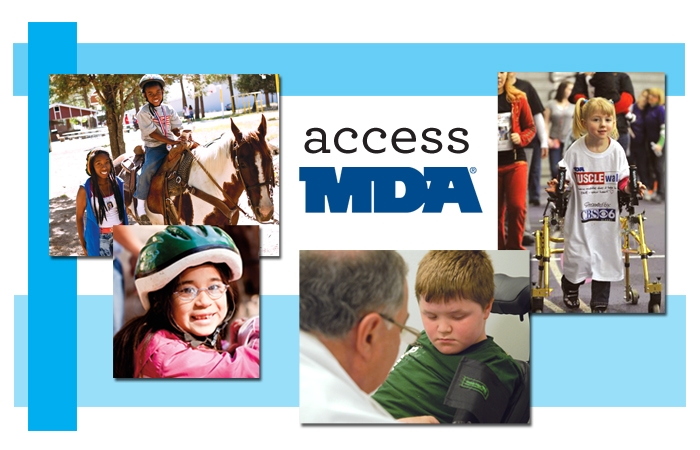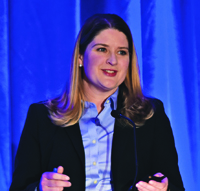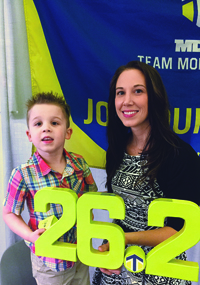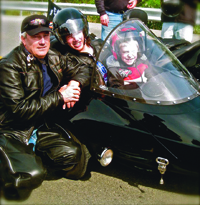
Access MDA Spring 2015

News and updates from the MDA community
A True Advocate: Kristin Stephenson, MDA’s new vice president of Policy and Advocacy, discusses her new role and her personal connection to MDA
 Kristin Stephenson, an accomplished lawyer and disability advocate, was announced as MDA’s new vice president of policy and advocacy earlier this year. Stephenson has worked in the clinical, consulting, administration and legal sectors of the health care industry. Beyond her vast experience with health care issues, she also has a personal connection to MDA’s cause.
Kristin Stephenson, an accomplished lawyer and disability advocate, was announced as MDA’s new vice president of policy and advocacy earlier this year. Stephenson has worked in the clinical, consulting, administration and legal sectors of the health care industry. Beyond her vast experience with health care issues, she also has a personal connection to MDA’s cause.
“I have dedicated my career to health care and public health issues, and have actively advocated for people with neuromuscular diseases since the late 1990s,” she says. “[However], my role with MDA is much more to me than just a job — my husband has Becker muscular dystrophy (BMD), so this position and its objectives are deeply meaningful to me. This role allows me the opportunity to dedicate myself every day to helping improve the lives of those in our community.”
Stephenson is looking forward to her new role and continuing to work and maintain relationships with people in the MDA community, as well as people and organizations that help MDA fulfill its lifesaving mission and provide support to families fighting back against muscle disease. Her top priorities in this new role include increasing grassroots participation in MDA’s advocacy efforts, working with entities that have the ability to impact the MDA community through policy and regulatory action — such as Congress, the National Institutes of Health (NIH) and the Food and Drug Administration (FDA) — and collaborating with other groups and organizations that also serve the MDA community to achieve common goals.
Although she just began her new role in January, Stephenson already has policy and advocacy efforts moving for 2015. In late January, the House of Representatives released draft language for a new bipartisan bill, called “21st Century Cures,” which aims to transform and expedite the process by which new treatments and cures are discovered, developed and delivered. The bill was shaped by comments from the MDA community, as well as many other contributors. MDA will continue to provide more feedback as the bill evolves to ensure the community’s voice is heard.
Additionally, MDA has filed comments in response to a Senate report titled “Innovation for Healthier Americans.” The report addresses important issues affecting the MDA community, and takes a focused look at how regulatory policies and procedures can be changed to be more modern and efficient in the development and delivery of treatments and cures. MDA also is in the process of working with the scientific community to develop a response to an FDA request for comment about the identification and use of biomarkers — biological indicators that give reliable information about the state of a disease as well as indications about whether an experimental therapy is working.
“Taking advantage of opportunities to provide information to our lawmakers and regulators is one way to make sure our community’s collective voice is heard in Washington,” Stephenson explains.
Other policy and advocacy developments on the horizon for Stephenson include President Obama’s Precision Medicine Initiative, which was unveiled as part of the new budget in January and will provide money to research more individualized treatments for patients; working to secure increased NIH funding for the fiscal year 2016 budget; and continuing the development of the transitions and newborn screening initiatives.
For more information about MDA’s advocacy efforts, visit MDA Advocacy section.
Running Mom: A first-time marathoner draws inspiration from her son to participate in MDA Team Momentum
Michelle Bussiere and her husband, David, had never heard of muscular dystrophy when their son, David (the third Bussiere to be named David, after his father and grandfather), was diagnosed with Duchenne muscular dystrophy (DMD) in 2011 at 19 months old. The doctor who revealed the diagnosis directed the family to MDA’s website; since then, Michelle Bussiere has been an MDA family all-star.
 Bussiere and her family are involved with MDA in many different ways, from participating in the MDA Lock-Up and thanking and speaking to families about Fill the Boot and shamrock campaigns to leading discussions and helping to increase engagement in their local family support group. Most recently, Bussiere joined MDA Team Momentum to run in support of her son and other families just like hers.
Bussiere and her family are involved with MDA in many different ways, from participating in the MDA Lock-Up and thanking and speaking to families about Fill the Boot and shamrock campaigns to leading discussions and helping to increase engagement in their local family support group. Most recently, Bussiere joined MDA Team Momentum to run in support of her son and other families just like hers.
“I always wanted to put together a run for MDA, but I was always thinking about a 5K — a marathon had never crossed my mind before,” says Bussiere. “It was just never really feasible [for me to put it together myself] because there’s so much that goes into it. So when Team Momentum came to town, so to speak, I was ready.”
Bussiere had never run a marathon before deciding to join MDA Team Momentum and participate in the Metro PCS Dallas Marathon in December 2014. In the beginning, she was nervous about the difficulty of the race; however, an experience she had in her first Team Momentum group run convinced her she could conquer the full 26.2 miles.
“I said [to the other runners in the group]: ‘You guys just go ahead,’ because I was really tired, and I was really slowing down the pace,” she says. “Instead, they put me in the front of the group and said I’d set the pace for everyone. That was a really cool thing that showed me that, as hard as it was, I could do it.”
When the day of the marathon finally came, Bussiere experienced the highs and lows of being a long-distance runner. In a post she made on Facebook reflecting on her experience, she described the marathon as “overwhelming, frustrating, inspiring, brutal, fun and exciting all at the same time.”
After finishing the marathon, Bussiere was already thinking about what was next.
“You cross the finish line, and you look back at it and you go ‘that just happened,’” she says. “It was kind of like childbirth. It was so hard and so painful, but once it’s done, the joy of it is incredible, and you can’t wait to do it again.”
Off to the Races
MDA Team Momentum has upcoming races across the country, including:
Colfax Marathon and Half Marathon, Denver, May 17
Michelob ULTRA Chicago Spring 13.1, Chicago, May 17
Boston’s Run to Remember, Boston, May 24
Bank of America Chicago Marathon, Chicago, October 11
Marine Corps Marathon, Washington, D.C., October 25
Metro PCS Dallas Marathon & Half-Marathon, Dallas, December 13
 Along for the Ride: Harley-Davidson riders give back through MDA Ride for Life
Along for the Ride: Harley-Davidson riders give back through MDA Ride for Life
Every year, hundreds of Harley-Davidson enthusiasts from six states — New Jersey, Maryland, Delaware, Northern Virginia, Pennsylvania and southern New York — come together to ride, enjoy musical performances and other special events, and, most importantly, raise funds and awareness to help save and improve the lives of children and adults fighting life-threatening muscle disease.
Sales professional Mike Dimov is one of those Harley-Davidson riders who has been coming to the Ride for Life event since 1998, when he started participating at the suggestion of his local Harley-Davidson dealer. Since then, Dimov hasn’t missed a ride; this year’s upcoming Ride for Life event in Tannersville, Pa., on May 1–3 will be his 18th. And while he only raised $35 back in 1998, last year Dimov was the No. 1 fundraiser for the event, personally raising $53,115 to help support MDA families.
Dimov still remembers that first ride, where he and his wife, Chris, were practically the only people with no Harley-Davidson gear.
“Chris was wearing a green rain slicker with whales on the lining, and I was wearing khakis, saddle shoes and a tan Member’s Only jacket,” Dimov recalls. “What a hoot [that was]!”
Dimov’s commitment to MDA’s cause was cemented when he met a young but already famous poet living with dysautonomic mitochrondrial myopathy (a genetic neuromuscular disease that impaired almost all of his body’s major functions, such as heart rate, breathing, blood pressure and digestion, and caused generalized muscle weakness) at an early Ride for Life event. That poet, Mattie J.T. Stepanek, passed away not long after in 2004 at age 13.
Since then, Ride for Life has become far more than another excuse for Dimov to ride. What brings him back year after year is seeing the other participants he has met over the years and participating in fundraising and the silent auction to help make a difference.
“Seeing the smiles on the kids’ faces when the dealers announce the final donations, and knowing that the money is going to support research and the kids’ favorite week of the year at MDA summer camp tops the list for me,” says Dimov, a longtime MDA summer camp volunteer.
For more information about MDA Ride for Life and how you can get involved, visit mdarideforlife.org. This year’s Ride for Life event will take place May 1–3 at the Camelback Resort in Tannersville, Pa.
Focus on the Future: The passing of the ABLE Act allows MDA families to make stronger financial plans
The ability of MDA families to save effectively for the future was ensured on at the end of 2014 when President Obama signed the Achieving a Better Life Experience (ABLE) Act into law. MDA Vice President of Policy and Advocacy Kristin Stephenson called the passing of the act “a success for the entire disability community.”
The ABLE Act allows Americans living with disabilities to save for the future via tax-free savings accounts, similar to those accounts Americans can already use to save for college and retirement without having to worry that their savings may disqualify them for other forms of support, such as Medicaid or SSI. Money set aside in an ABLE account can be used for any qualified expense, which include transportation, education, housing, assistive technology and other disability-related expenses.
“The bottom line is that now families in the disability community can save money and plan ahead in a way that was never before possible,” Stephenson says.
More details about how ABLE accounts will work — such as necessary documentation required, tax-reporting policies and what expenses qualify under the Act — will become clear later this year as states begin to implement the program.
For more information about the ABLE Act, check out MDA’s related resources at MDA Advocacy, and look for more coverage in future issues of Quest.
Get Moving: Join an MDA Muscle Walk in 2015
Every day, in communities everywhere, muscular dystrophy, ALS and other life-threatening diseases take away the ability to walk, move, smile, talk and even breathe. With MDA Muscle Walk you can fight back. For yourself. For your loved one. For your family member, friend, co-worker, neighbor — for all the people across the United States who are counting on us. Together with the Muscular Dystrophy Association, we can make sure everyone has the chance to chase their dreams — freely and independently without barriers or assistive care.
Join us for MDA’s Muscle Walk — the most inspiring event of its kind that creates hope and progress in the fight against muscle disease. Start or join a team, fundraise or volunteer to make the event special. More than 150 Muscle Walk events will take place across the nation in 2015. Visit mdamusclewalk.org to find a walk near you.
MDA Resource Center: We’re Here For You
Our trained specialists are here to provide one-on-one support for every part of your journey. Send a message below or call us at 1-833-ASK-MDA1 (1-833-275-6321). If you live outside the U.S., we may be able to connect you to muscular dystrophy groups in your area, but MDA programs are only available in the U.S.
Request Information